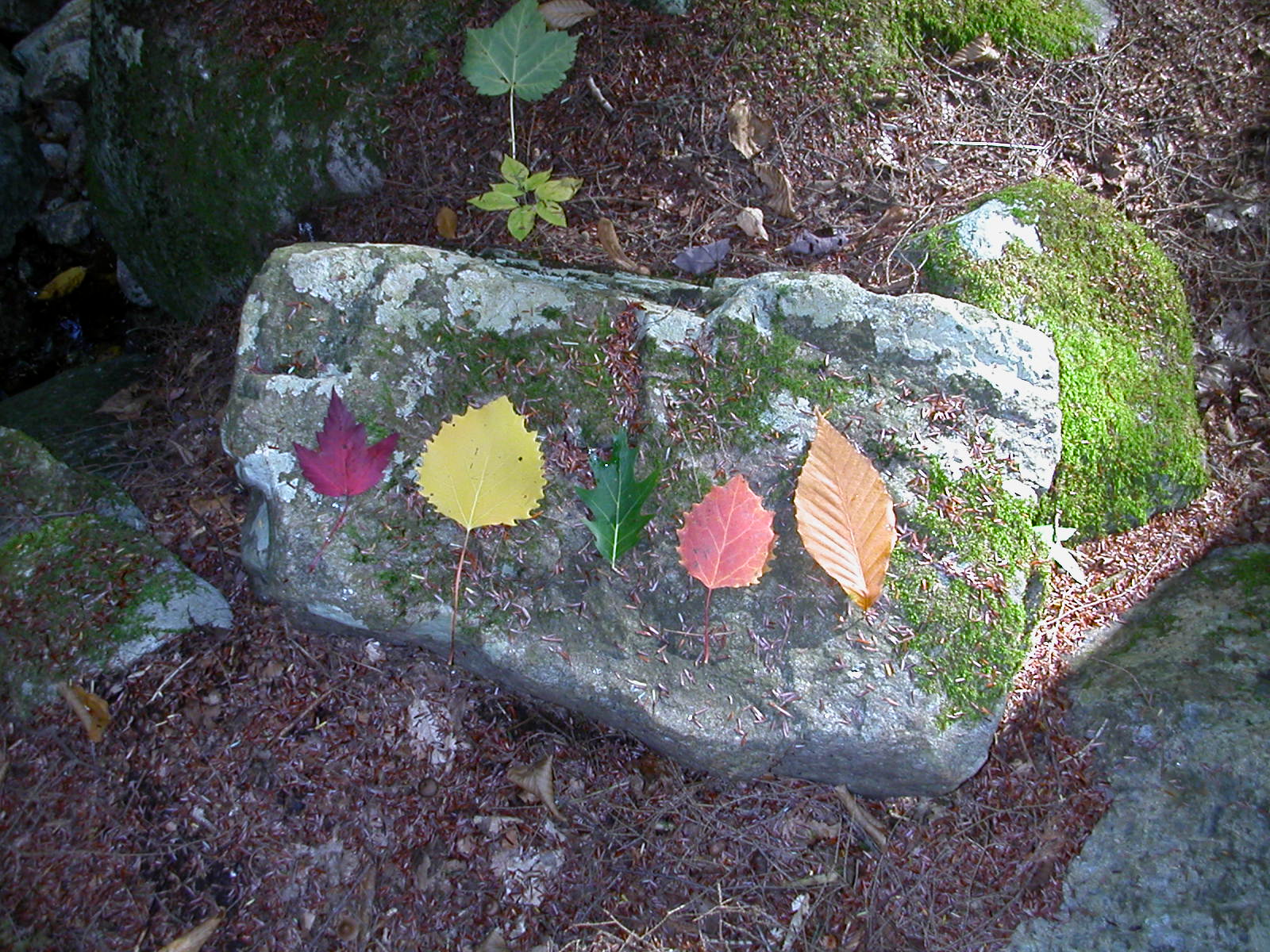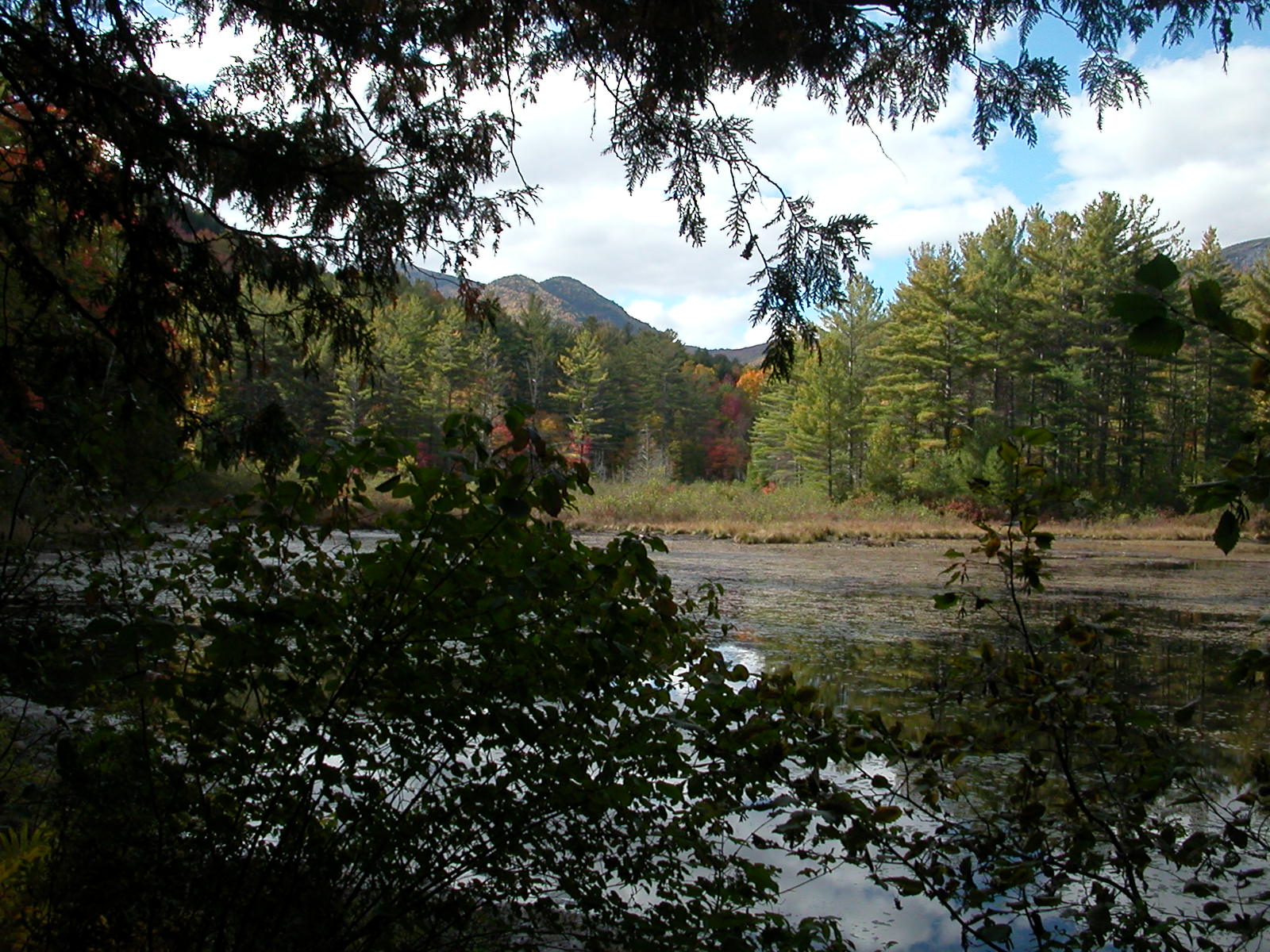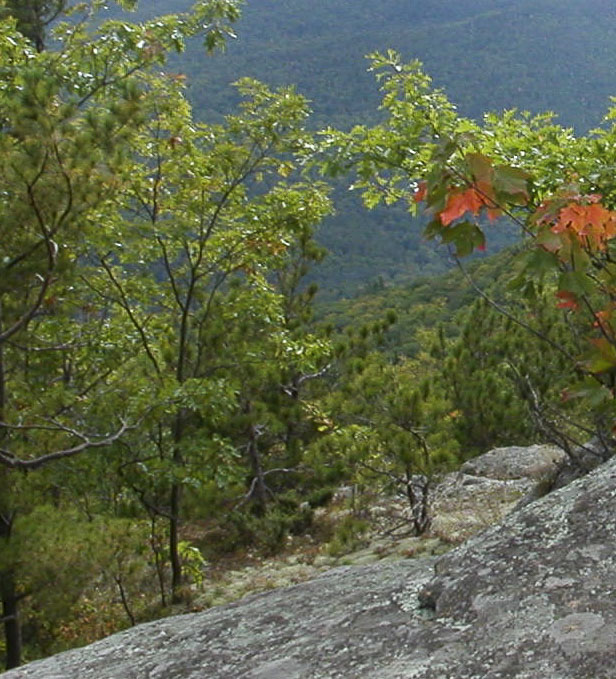Leaning into the Curve
September 30, 2016I hope everyone’s Equinox was satisfactory and that the New Moon brings good happenings. Mercury retrograde in Virgo was intense, wasn’t it? And with a lunar and solar eclipse going on as well. I had my hot water, my washing machine, and my heat quit on me. You might think losing heat is no big deal in September, but not in the Adirondacks. Fortunately I now have a new hot water tank, I have a new washer/dryer, and the landlord is working on installing a new boiler, which is a rather involved proposition.
I am finding time to enjoy the out-of-doors in the most beautiful season of the most beautiful place to hike on earth. This is from the Giant mountain range on Wednesday.
Elen of the Ways
September 23, 2016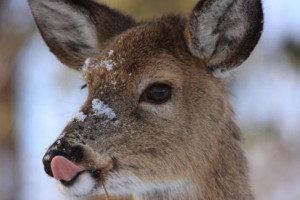
Again from my forthcoming book on animal divination:
An increasingly popular conception of the Deer Goddess goes by the name of Elen or Elen of the Ways. Knowledge about this goddess was disseminated through the research of Caroline Wise(1) on Elen of the Hosts, who appears in a short section of the Welsh Mabinogion. While researching ley lines in Britain, Wise discovered this passage:
…Elen thought to make high roads from one stronghold to another across the Island of Britain. And the roads were made. And for that reason they are called the Roads of Elen of the Hosts, because she was sprung from the Island of Britain, and the men of the Island of Britain would not have made those great hostings for any save for her.(2)
The “hosts” refers to the army that utilized Elen’s roads. Elen of the Hosts is a historical figure, the queen of a usurper in the Gaulish Empire who assassinated the Emperor Gracian. Also known as Saint Helen (and not to be confused with the Saint Helen who is mother of the Emperor Constantine), she is reputed to have established Christianity in Wales. Wise theorized that the roads of Saint Helen were created by migrating reindeer, and that the Elen of the Hosts described in the Mabinogion is conflated with an older deer goddess. The most convincing part of her argument, from a scholarly point of view, is the prevalence of deer words sounding like Elen in many European languages. My Google translator confirms that “eilit” is Irish Gaelic for “doe,” while “jelen” is Polish for “deer” and “elen” is Bulgarian for “deer.” “Elain” is Finnish for “animal.” The Dictionary of Word Origins has this to say about the English word “elk”:
The Indo-European base *ol-, *el- produced a number of words for deer-like animals – Greek elaphos ‘stag,’ for example and Welsh elain ‘hind,’ not to mention English eland.(3)
“Elen” may be a root Indo-European word for “deer,” and if so would be an appropriate appellation for the Deer Goddess. If the roads of Elen were established by reindeer, however, it is doubtful that a reindeer goddess was worshiped on the British Isles at that earlier time by that name, since the large scale Indo-European migrations, unlike those of the reindeer, were fairly recent.
The most compelling case for Elen as a deer deity is the number of people who attest to connecting strongly with a deer goddess by this name. Chesca Potter seems to be the first modern artist to channel Elen as Reindeer Woman in the 1980s, but Elen is probably now the most commonly depicted Horned Goddess.
(1) Caroline Wise, “Elen of the Ways,” andrewcollins.com, http://www.andrewcollins.com/page/articles/elen_1.htm accessed July 9, 2016.
(2)The Mabinogion, translated by Gwen Jones and Thomas Jones, (New York: Alfred A. Knopf, 2001), 77.
(3) John Ayto, Dictionary of Word Origins, (New York: Arcade), 197.
Further Reading
Wise, Caroline. Finding Elen: The Quest for Elen of the Ways. London: Eala Press, 2015.
Sentier, Elen. Elen of the Ways: Following the Deer Trods Hants, UK: Moon Books, 2013.
Reindeer and the World Tree
September 16, 2016
More from my forthcoming book on animal divination:
The stag of Artemis being in fact a reindeer raises questions about the four stags who nibble on the branches of the Germanic world tree, Yggdrasil. This is the tree that holds the nine worlds, three each in the lower, middle, and upper regions. A snake nibbles at the roots of the tree, an eagle claims the high branches, and four deer browse the foliage. These animals create balance by tempering the growth of the ever-growing tree. The deer are identified as stags in the only source that mentions them, the Prose Edda, so this is not a case of a picture being misinterpreted, at least not in modern times. It is curious that reindeer would not be prominent in the mythology of the Norse, when reindeer memory survives as far south as Greece. Another stag, called Eikthyrnyr, lives atop a tree called Laerad in Odin’s upper realm of Valhalla. Eikthyrnyr munches the leaves of Laerad along with a nanny goat named Heidrun. From the udders of Heidrun flow mead. From the antlers of Eikthyrnyr flow the waters that make up the rivers of the worlds. Eikthyrnyr could also be a reindeer doe. Default male bias being the pervasive affliction that it is, assertions of maleness in animal deities must be entertained with skepticism. The presence of so-called stags where we would expect to find reindeer, amid the absence of mention of any does, suggests either naiveté or a patriarchal rewriting of mythology.
Artemis and the Reindeer Doe
September 9, 2016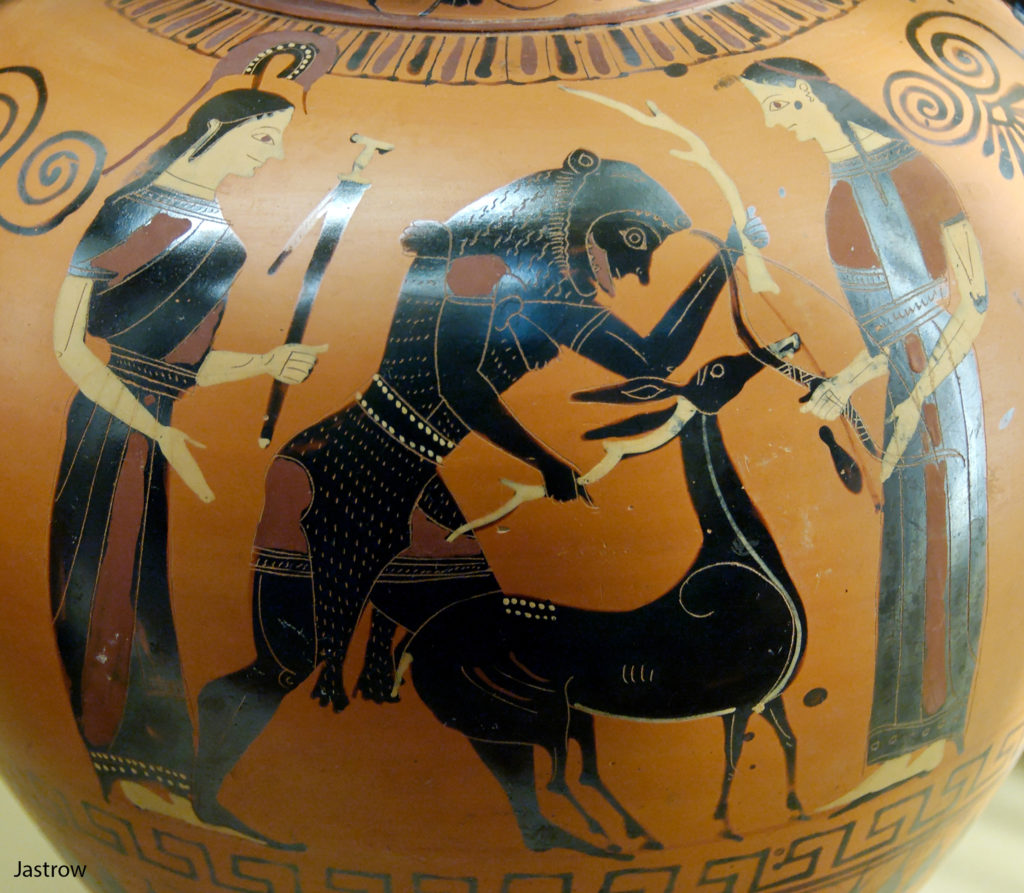
Here is another short excerpt from my forthcoming book about animal divination:
In antiquity the deer familiar of Artemis was a reindeer, which some confuse with a stag. Both horned and hornless does are depicted driving the goddess’s chariot. These does are magical and can run faster than an arrow. A fifth doe, called the Ceryneian Hind, was too fast even for Artemis to catch, but the doe was later given to her by one of the Pleiades sisters, Taygete. The third labor of Heracles (Hercules) involves capturing the Ceryneian Hind and bringing her alive to Mycenae, a city in the Argolis region of the Peloponnese. This quest, which takes exactly one year, begins at the temple of Artemis in Oenoe (the Oenoe located in Argolis). Though the journey begins and ends in about the same place, Heracles chases the Hind through the upper Balkan region and into Hyperborea, a vaguely defined place in the north. The indomitable Hind then leads Heracles south to the temple of Artemis atop Mount Artemisium, where she allows herself to be captured. This is a shaman’s journey, an initiation into the cult of Artemis. The giant Hind, with her gold antlers and brass hooves, may have been a statue in the temple with those features.
The Deer Shifters: Another deer article from the past
September 2, 2016Several years ago a North Country man shot and killed a member of his hunting party, the girlfriend of his son. This is an all too frequent tragedy, not worth a mention anywhere but the local news. The man said he thought the girlfriend was a deer, which is also not so unusual. More perplexing is that the woman was standing not far away from the shooter and was immobile, leaning against a tree. Regardless, the victim’s family and the prosecutor believed this was an accident, and the shooter was offered a reduced prison sentence that left some observers looking askance. Was it plausible that a sober man with good eyesight could accidentally shoot a person at close range, no matter how crazed he was to “get his buck”?
Or, could the victim-hunter – thinking about the deer, struggling to perceive the deer, trying to get in the mind of the deer, willing the deer to come closer – actually have turned into a deer? This alternative may seem more fantastic than the first, yet I have seen women (always women for some reason) momentarily turn into deer.
Moreover, I once received validation of sorts for my perception, during a women’s ritual. I glanced over to the woman beside me and saw that she had turned into a deer, and I thought I must be mistaken. This woman was very infatuated with bears, and I would never have associated her with deer. She was not fazed by this, however, explaining that her Cherokee great-grandmother had believed her to be attuned with the deer and had lobbied unsuccessfully to give her a deer name.
In the story of Sadb and Oisin the Irish heroine Sadb is turned into a fawn by one of her father’s enemies. She evidently retains the power to change back and forth, because she becomes the lover of the hero Fionn Mac Cumhaill after he spares her cervid form during a hunting expedition. The enraged druid changes her back into a doe, this time permanently, and in this form she gives birth to their son Oisin. The child appears human in all ways, save for a fawnlike forelock of hair, yet he can run as fast as a deer. (A slightly different version of this story appears in my book Invoking Animal Magic.)
The Scottish hag Beinne Bhric changes into a gray deer, echoing legends of the Cailleach Bheur, the giant crone who keeps a herd of magic deer. The generic Scottish word for a shape-shifting charm, fith-fath (fee faw), literally means to take the shape of a deer.
Make no mistake: women can take the shape of deer, at least some women can. It is the stuff of legend, but nonetheless true. Serious inquiry has not been made into the qualities of the children of doe-mothers, but perhaps this is how shape-shifting ability is passed on. If you think you might be part deer, make your way carefully in the woods.
Sources:
Celtic Mythology. New Lanark, Scotland: Geddes and Grosset, 1999.
Matthews, Caitlin and John. The Encyclopedia of Celtic Wisdom: The Celtic Shaman’s Sourcebook. Shaftsbury, UK: Element Books, 1994.
Monaghan, Patricia. The Encyclopedia of Celtic Mythology and Folklore. New York: Checkmark Books, 2008.
Deer Photos on Tumblr
August 26, 2016
I have sixteen cool pictures of deer (reblogged) on my Tumblr site.
Call of the Deer
August 19, 2016
The deer family is composed of deer, caribou, elk, and moose. Con Slobodchikoff, in Chasing Doctor Doolittle, describes communication within the deer family (and many other species). He says regarding elk:
The bugling starts off as a long, eerie low-frquency screeching sound, followed by a series of three or four shorter sounds kind of like someone scratching glass on concrete. The first time one of my graduate students, newly arrived from the East Coast, heard this sound on a dark evening in the mountains he was startled and disoriented.… I told him he had heard the aggressive call of a male elk (Cervus canadensis), advertising his presence to other males and perhaps also to any females that happened to be nearby. When you hear it for the first time, it can be pretty terrifying.
Here is a male elk bugling:

Dr. Slobodchikoff goes on to discuss the call of the Red Deer stag:
Although red deer (Cervus elaphus) are similar in size and shape to elk, and in fact were thought for a long time to be the same species of animal, their calls are very different. Red deer are found in Europe, Western Asia, and Northern Africa. They have a roaring call that advertises their aggressiveness toward other males, and they make this call during the mating season when they are guarding a harem of females. Depending on the size of their opponents, the males can vary the base pitch of their roars, making the roars sound deeper when they are faced with a larger opponent. This gradation in the base pitch of the roars probably conveys information to challengers about the males’ willingness and ability to fight to defend her harem.
Source:
Con Slobodchikoff, Chasing Doctor Doolittle: Learning the Language of Animals (New York: St. Martin’s Press, 2012) 185-186.
Diana and the Deer
August 12, 2016
August 13 marks the start of an ancient Roman festival to Diana. Torches were carried in processions in honor of the goddess with the aim of averting storms which might imperil the ripening harvest. The torch is one of Diana’s symbols, as she is the goddess who governs light.
Thinking of Diana as goddess of light fits with another of her symbols, the deer. In earlier posts I wrote about how deer migrations are so closely aligned with solar rhythms that in many cultures deer goddesses are also sun goddesses. Many other animals have rhythms ruled by the sun that are noticeable to us, of course, but deer were once a staple in the human diet.



